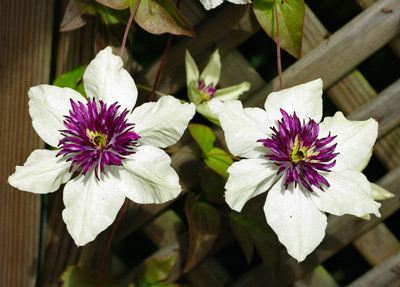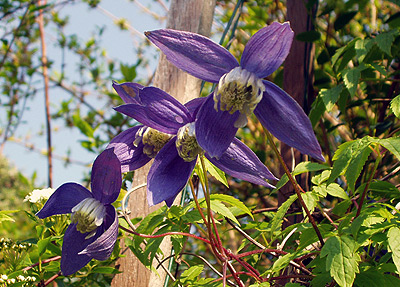Clematis - Varieties and Care
Hardy Perennials
Clematis are a group of fabulous flowering climbers of greater
variation, range of colours, size and shape of flower than often
appreciated.
Clematis climb by means of twining leaf stalks and so need something to hold onto. Like many climbers they do better if allowed to grow in three dimensions rather than two i.e. over a pergola, obelisk or similar rather than just up a trellis on a wall. They can do well on a trellis, but expect them to grow outwards to some degree as well as up. A trellis / wall / fence behind a narrow border is good for them. If putting up trellis, keep it away from the brickwork an inch or two with battens or spacers rather than try getting the plant to grow flush up against it.
Clematis can also be allowed to climb over or through trees or shrubs and do well in pairs giving two complimentary or contrasting colours. Make sure you don't mismatch the vigour or you might just get one of them taking over. The less vigorous late flowering types are good trained through large shrub or climbing roses.
Care of Clematis
The true species are often much easier to grow than the named varieties and suffer from less pest and disease trouble too.
All Clematis do best in reasonably light, slightly alkaline soil that is rich in nutrients. They don't do well in poor soils, heavy wet clays or strongly acidic soils. If your soil is heavy, then incorporate plenty (at least a bucketful) of organic matter, garden compost, well rotted manure or similar into the planting hole and mix well with the soil. Dig a planting hole, fill it with organic material and mix it well with the surrounding soil. If you've particularly heavy soil, mixing in some pea gravel will also help.
Smaller Clematis can be planted in containers, bear in mind that a containerised climber should have the support contained within the pot. If it's in a container and clinging to something else, things can get difficult when you come to move the container or if you decide it's time to re-pot. You also need to think about the positioning, a large Clematis clad trellis in a pot acts like a sail in the wind, position it in a sheltered place or anchor it in some way.
Clematis are plants of woodland clearings and hedges, in the main they like their roots to be in the cool, down amongst the shade and their heads up in the sun. There are Clematis for almost any situation, but different varieties have their own particular preferences. Evergreen forms and some of the late flowering ones need (need - not would prefer) the shelter of a warm and sunny wall. Many of the early large flowered hybrids give their best colours if slightly shaded. In full bright sunlight, the colours can be bleached making the different varieties look very similar.
All deciduous types are fully hardy in the UK, the evergreen varieties are less so with some being borderline. Double and semi-double flowered types need a sunny, warm sheltered site.
Planting: Clematis should be planted deeply, up to 6 inches below the soil mark on the plant in its pot. If your plant is small when putting it in the soil, it is a good idea to let it grow on a bit first.
Mulch Clematis well in autumn and again in spring with more organic matter. A top dressing of slow release fertiliser in spring is appreciated, gromore or blood, fish and bone. Feed Clematis about every three weeks through the growing season, but not when they're in full flower.
The pruning of Clematis varies according to flowering time. Plants are divided into three groups for this purpose.
Group 1 Clematis:
Flower early in the spring.
Not as early as spring bulbs, but a beautiful and valuable addition to the spring garden.
They flower on the wood produced in the previous growing season. As the grouping is determined by flowering time and pruning requirements, it is made up of a number of different species and a great many cultivars and named varieties
Pruning: If pruning is necessary (if you're happy with the size of plant and where it's growing, then by all means leave it until it needs it) then it should be carried out immediately after flowering.
Cut back too-long shoots to healthy buds and remove any dead wood only when frost danger has passed. Old congested plants can be thinned by removing about 1 in 3 woody shoots. If total renovation is needed they can be cut right back to the base, 6-12 inches above the ground just after flowering - don't do this again for at least three years though.
 Clematis alpina Pamela Jackman |  Clematis Bredon Blue |  Clematis Early Sensation |
 Clematis Guiding Promise Boulevard |  Clematis montana Rosebud |  Evergreen Clematis Cartmanii Joe |
 Fragrant Clematis Kimiko |
Group 2 Clematis:
Flower in the spring and then again often later on in the season in the autumn.
The later flush of flowers not being as great as the first. There are a great number of hybrids in this group and so actual flowering times and durations vary enormously.
They flower on the wood produced in the previous growing season. As the grouping is determined by flowering time and pruning requirements, it is made up of a number of different species and a great many cultivars and named varieties.
Pruning: Prune in late winter or early spring before any new growth has emerged. Cut back too-long shoots to healthy buds and remove any dead wood only when frost danger has passed. Old congested plants can be thinned by removing about 1 in 3 woody shoots. If total renovation is needed they can be cut right back to the base, 6-12 inches above the ground just after flowering - don't do this again for at least three years though.
This group generally need little in the way of pruning. If hard pruning is required, the spring flowers are usually lost, but the later flush in the first year will be much better, then the plant can get back to normal the year after.
Group 3 Clematis:
Flower late in the summer on the current years growth.
As the grouping is determined by flowering time and pruning requirements, it is made up of a number of different species and a great many cultivars and named varieties.
Pruning: Well established plants should be pruned back hard or vigour and flowering performance will decline. Also, you may find that eventually the plant flowers up in the air somewhere and not at a sensible height if left to its own devices.
Prune in late winter or early spring when the buds are showing signs of growth. Cut main stems back to a strong pair of buds 6-12 inches above the ground. If any stems have been killed cut them right out, back to ground level if necessary.
Copyright 2000 - present. All Rights Reserved | Privacy Policy Statement















